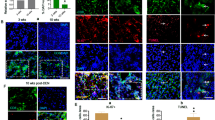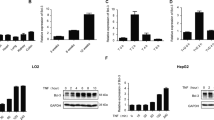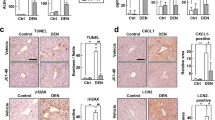Abstract
Interleukin-6 (IL-6) is a pleitrophic cytokine that not only regulates growth and differentiation of many cell types, but also induces production of acute phase proteins (AAP) in hepatocytes. Our previous works have demonstrated that both PI 3-K/Akt and STAT3 pathways were concomitantly activated and cooperatively mediated the anti-apoptotic effect of IL-6. This investigation reports that IL-6 protected cells against apoptosis induced by a variety of agents including, TGF-β, UV and retinoic acid (RA) in Hep3B cells, suggesting that IL-6 is a fundamental determinant of hepatic cell survival. Mcl-1, but not other Bcl-2 family members, was rapidly up-regulated by IL-6, with a peak (approximately 3–4-fold) appearing at 4 h. Transient transfection of cells with a mcl-1 antisense vector, resulting in a 50–60% reduction of the anti-apoptotic effect of IL-6, indicating that Mcl-1 is a downstream effector of IL-6. Which signaling pathway transduced by IL-6 responsible for the Mcl-1 up-regulation was further investigated. In Hep3B cells, the JAK/STAT3, ERK, and PI 3-K/Akt pathways were activated by IL-6 stimulation. Blocking JAK/STAT3 activation with a dominant-negative mutant STAT3F or a JAK inhibitor AG490 could not influence IL-6-mediated Mcl-1 up-regulation. Similarly, PD98059 treatment, a MEK specific inhibitor, also failed to inhibit Mcl-1 expression. However, the IL-6-induced Mcl-1 up-regulation was effectively attenuated in the presence of PI 3-K inhibitors, LY294002 and wortmannin. Expression of dominant-negative Akt, but not Etk, could abrogate the IL-6-induced increase of Mcl-1. In conclusion, our results suggest that the anti-apoptotic effect of IL-6 is mediated, at least in part, by Mcl-1 expression and that is mainly through the PI 3-K/ Akt-dependent pathway.
This is a preview of subscription content, access via your institution
Access options
Subscribe to this journal
Receive 50 print issues and online access
$259.00 per year
only $5.18 per issue
Buy this article
- Purchase on Springer Link
- Instant access to full article PDF
Prices may be subject to local taxes which are calculated during checkout







Similar content being viewed by others
References
Ahmed NN, Grimes HL, Bellacosa A, Chan TO and Tsichlis PN. . 1997 Proc. Natl. Acad. Sci. USA 94: 3627–3632.
Akira S, Nishio Y, Inoue M, Wang XJ, Wei S, Matsusaka T, Yoshida K, Sudo T, Naruto M and Kishimoto T. . 1994 Cell 77: 63–71.
Andrejko KM, Chen J and Deutschman CS. . 1998 Am. J. Physiol. 275: G1423–G1429.
Boulton TG, Stahl N and Yancopoulos GD. . 1994 J. Biol. Chem. 269: 11648–11655.
Burgering BMT and Coffer PJ. . 1995 Nature 376: 599–602.
Cardone MH, Roy N, Steunicke HR, Salvesen GS, Franke TF, Stanbridge E, Frisch S and Reed JC. . 1998 Science 282: 1318–1321.
Chao JR, Wang JM, Lee SF, Peng HW, Lin YH, Chou CH, Li JC, Huang HM, Chou CK, Kuo ML, Yen JJ-P and Yang-Yen HF. . 1998 Mol. Cell. Biol. 18: 4883–4898.
Chen RH and Cheng TY. . 1997 Cell Growth Diff. 8: 821–827.
Chen RH, Su YH, Chuang RLC and Chang TY. . 1998 Oncogene 17: 1959–1968.
Chen RH, Chang MC, Su YH, Tsai YT and Kuo ML. . 1999 J. Biol. Chem. 274: 23013–23019.
Cressman DE, Greenbaum LE, DeAngelis RA, Ciliberto G, Furth EE, Poli V and Taub R. . 1996 Science 274: 1379–1383.
Daeipour M, Kumar G, Amaral MC and Nel AE. . 1993 J. Immunol. 150: 4743–4748.
Datta SR, Dudek H, Tao X, Masters S, Fu H, Gotoh Y and Greenberg ME. . 1997 Cell 91: 231–241.
DiCristofano A and Pandolfi PP. . 2000 Cell 100: 387–390.
Franke TF, Yang SI, Chau TO, Datta CK, Kazlauskas A, Morrison DK, Kaplan DR and Tsichlis PN. . 1995 Cell 81: 727–736.
Hockenbury DM. . 1992 Semin. Immunol. 4: 413–420.
Kauffmann-Zeh A, Rodriguez-Viciana P, Gilbert C, Coffer P, Downward J and Evan G. . 1997 Nature 385: 544–548.
Kennedy SG, Wagner AJ, Conzen SP, Bellacosa A, Tsichlis PN and Hay N. . 1997 Genes Dev. 11: 701–713.
Kovalovich K, Deangells RA, Li W, Furth EE, Ciliberto G and Taub R. . 2000 Hepatology 31: 149–159.
Kozopas KM, Yang T, Buchan HL, Zhou P and Craig RW. . 1993 Proc. Natl. Acad. Sci. USA 90: 3516–3520.
Kulik G, Klippel A and Weber MJ. . 1997 Mol. Cell. Biol. 17: 1595–1606.
Kumar G, Gupta S, Wang S and Nel AE. . 1994 J. Immunol. 153: 4436–4442.
Kuo ML, Meng TC and Lin JK. . 1996 Carcinogenesis 17: 815–820.
Lutticken C, Wegenka VM, Yuan J, Buschmann J, Schindler C, Ziemiecki A, Harpur AG, Wilks AF, Yasukawa K, Taga T, Kishimoto T, Barbirri G, Pellegrini S, Sendtner M, Heinrich PC and Horn F. . 1994 Science 263: 89–92.
Maione D, Carlo ED, Li W, Musiani P, Modesti A, Peters M, Rose-John S, Rocca CD, Tripodi M, Lazzaro D, Taub R, Savino R and Ciliberto G. . 1998 EMBO J. 17: 5588–5597.
Malasuranera M, DiFazio I, Romeo MA, Restuccia S, Laurino A and Trovato BA. . 1997 J. Gastroenterol. 32: 211–215.
Michalpoulos GK and DeFrances MC. . 1997 Science 276: 60–66.
Minshall C, Arkins S, Freund GG and Kelley KW. . 1996 J. Immunol. 156: 939–947.
Murakami M, Hibi M, Nakagawa N, Yasukawa K, Yamanish K, Taga T and Kishimoto T. . 1993 Science 260: 1808–1810.
Nakajima K, Yamanaka Y, Nakae K, Kojima H, Ichiba M, Kiuchi N, Kitoka T, Fukada T, Hibi M and Hirano T. . 1996 EMBO J. 15: 3651–3658.
Narazaki M, Wittuhn BA, Yoshia K, Silveunoineu O, Yasukawa K, Ihle JN, Kishmoto T and Taga T. . 1994 Proc. Natl. Acad. Sci. USA 91: 2285–2289.
Ogata A, Chauhan D, Teoh G, Treon SP, Urashima H, Schlissman RL and Anderson KC. . 1997 J. Immunol. 159: 2212–2221.
Oyanagi Y, Takahashi T, Matsui S, Takahashi S, Boku S, Takahashi K, Furukawa K, Arai F, Asakura H. . 1999 Liver 19: 464–472.
Puthier D, Bataille R and Aminot M. . 1999 Eur. J. Immunol. 29: 3945–3950.
Qiu Y, Robinson D, Pretlow TG and Kung HJ. . 1998 Proc. Natl. Acad. Sci. USA 95: 3644–3649.
Reynolds JE, Yang T, Qian L, Jenkinson JD, Zhou P, Eastman A and Craig RW. . 1994 Cancer Res. 54: 6348–6352.
Robinson DF, He F, Pretlow T and Kung HJ. . 1996 Proc. Natl. Acad. Sci. USA 93: 5958–5962.
Sadowski HB, Shuai K, Darnell Jr JE and Gilman MZ. . 1993 Science 261: 1739–1744.
Scheid MP and Duronio V. . 1998 Proc. Natl. Acad. Sci. USA 95: 7439–7444.
Skorski T, Bellacosa A, Nieborowska-Skorska M, Majewski M, Martinez R, Choi JK, Trotta R, Wlodarski P, Perrotti D, Chan TO, Wasik MA, Tsichlis PN and Calabretta B. . 1997 EMBO J. 16: 6151–6161.
Songyang Z, Baltimore D, Cantley LC, Kaplan DR and Franke TFC. . 1997 Proc. Natl. Acad. Sci. USA 94: 11345–11350.
Suzuki A, Tsutomi Y, Yamamoto N, Shibutani T and Akahame K. . 1999 Mol. Cell. Biol. 19: 3842–3847.
Toretsky JA, Thakar M, Eskenazi AE and Frantz CN. . 1999 Cancer Res. 59: 5745–5750.
Townsend KJ, Trusty JL, Traupman MA, Eastman A and Craig RW. . 1998 Oncogene 17: 1223–1234.
Tsai YT, Su YH, Fang SS, Huang TN, Qiu Y, Jou YS, Shih HM, Kung HJ and Chen RH. . 2000 Mol. Cell Biol. 20: 2043–2054.
Wang JM, Chao JR, Chen W, Kuo ML, Yen JJ and Yang-Yen HF. . 1999a Mol. Cell Biol. 19: 6195–6206.
Wang Y, Ripperger J, Fey GH, Samols D, Kordula T, Wetzler M, Van Etten RA and Baumann H. . 1999b Hepatology 30: 682–697.
Yamada Y, Kirillova I, Peschon JJ and Fausto N. . 1997 Proc. Natl. Acad. Sci. USA 94: 1441–1446.
Yang T, Buchar HL, Townsend KJ and Craig RW. . 1996 J. Cell Physiol. 166: 523–536.
Zhang X, Wrzeszczynska MH, Horvath CM and Darnell Jr JE. . 1999 Mol. Cell Biol. 19: 7138–7146.
Acknowledgements
The authors would like to thank the National Health Research Institute of Taiwan for financially supporting this research under Contract No. NHRI-GT-EX 89S 829P. Dr R-H Chen is also appreciated for providing various cell lines expressing Akt, P110*, Etk and their dominant-negative mutants.
Author information
Authors and Affiliations
Rights and permissions
About this article
Cite this article
Kuo, ML., Chuang, SE., Lin, MT. et al. The involvement of PI 3-K/Akt-dependent up-regulation of Mcl-1 in the prevention of apoptosis of Hep3B cells by interleukin-6. Oncogene 20, 677–685 (2001). https://doi.org/10.1038/sj.onc.1204140
Received:
Revised:
Accepted:
Published:
Issue Date:
DOI: https://doi.org/10.1038/sj.onc.1204140
Keywords
This article is cited by
-
Various pathways of zoledronic acid against osteoclasts and bone cancer metastasis: a brief review
BMC Cancer (2020)
-
Reactive oxygen species generation and mitochondrial dysfunction for the initiation of apoptotic cell death in human hepatocellular carcinoma HepG2 cells by a cyclic dipeptide Cyclo(-Pro-Tyr)
Molecular Biology Reports (2020)
-
Reawakening of dormant estrogen-dependent human breast cancer cells by bone marrow stroma secretory senescence
Cell Communication and Signaling (2018)
-
Targeted disruption of TC-PTP in the proliferative compartment augments STAT3 and AKT signaling and skin tumor development
Scientific Reports (2017)
-
Multiple gene aberrations and breast cancer: lessons from super-responders
BMC Cancer (2015)



